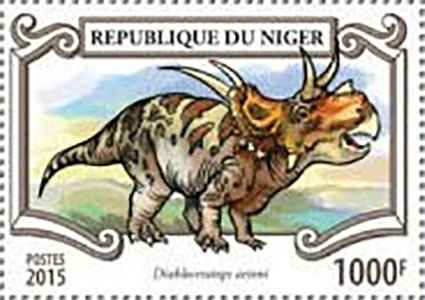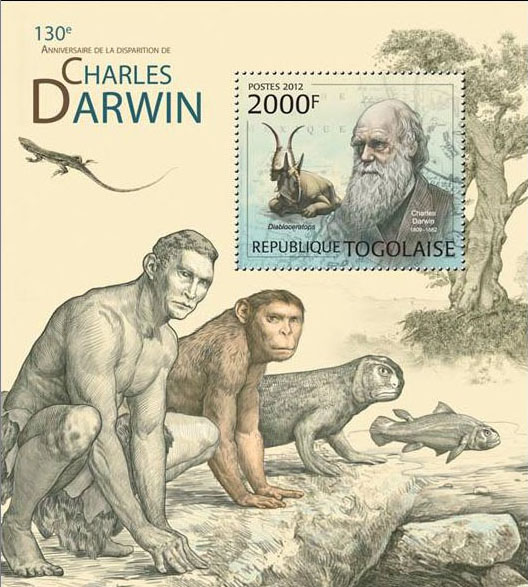Diabloceratops eatoni Kirkland and Deblieux, 2010

(Da: it.wikipedia.org)
Phylum: Chordata Haeckel, 1874
Subphylum: Vertebrata Cuvier, 1812
Classe: Dinosauria Owen, 1841
Ordine: Ornithischia Seeley, 1888
Famiglia: Ceratopsidae Marsh, 1890
Genere: Diabloceratops Kirkland and Deblieux, 2010
Descrizione
Questo animale è conosciuto principalmente per un cranio quasi completo e parte della mandibola. Il cranio presenta le caratteristiche tipiche dei ceratopsidi (becco da pappagallo, corna e collare osseo) ma l'aspetto era piuttosto inusuale, a causa della disposizione delle corna. Erano presenti due corna relativamente corte sopra gli occhi, mentre sul naso era presente una sorta di abbozzo osseo che dava origine a una sorta di doppia gobba. Il collare, piuttosto corto, era dotato di ampie "finestre" e di due lunghe spine proiettate all'infuori, che conferivano all'animale un aspetto "diabolico" (da qui il nome Diabloceratops). Descritto nel 2010, il diabloceratopo è considerato un rappresentante primitivo della famiglia dei ceratopsidi; in particolare, i paleontologi ritengono che appartenesse alla sottofamiglia dei centrosaurini, che comprendeva altri dinosauri cornuti dotati di un collare spinoso, come lo Styracosaurus, il Rubeosaurus ed l’Einiosaurus. A differenza di questi ultimi, il Diabloceratops possedeva una caratteristica primitiva, che tra i dinosauri cornuti si riscontra unicamente nella famiglia dei protoceratopsidi: la presenza di un'ulteriore apertura nel cranio. Questa apertura, nei ceratopsidi più evoluti, andò riducendosi fino a scomparire. James Ian Kirkland, che descrisse per primo il Diabloceratops, interpretò questa caratteristica come una prova della possibilità che le più antiche specie di dinosauri cornuti non formassero un singolo gruppo naturale, ma piuttosto si presentassero come una serie di forme graduali, sempre più vicine all'origine dei veri ceratopsidi.
Diffusione
Visse nel Cretaceo superiore (Santoniano/Campaniano, tra 84,9 e 70,6 milioni di anni fa) e i suoi resti fossili sono stati ritrovati in Nordamerica (Utah).
Bibliografia
–Kirkland, J.I. and DeBlieux, D.D. (2010). "New basal centrosaurine ceratopsian skulls from the Wahweap Formation (Middle Campanian), Grand Staircase-Escalante National Monument, southern Utah", In: Ryan, M.J., Chinnery-Allgeier, B.J., and Eberth, D.A. (eds.) New Perspectives on Horned Dinosaurs: The Royal Tyrrell Museum Ceratopsian Symposium. Bloomington, Indiana University Press, pp. 117-140
–Glut, D. F., 2012, Dinosaurs, the Encyclopedia, Supplement 7: McFarland & Company, Inc, 866pp.
–"DIABLOCERATOPS". Retrieved 11 December 2013.
–J. I. Kirkland and D. D. DeBlieux. 2007. New horned dinosaurs from the Wahweap Formation, Grand Staircase-Escalante National Monument, southern Utah. Utah Geological Survey Notes 39(3): 4-5.
–Kentaro Chiba; Michael J. Ryan; Federico Fanti; Mark A. Loewen; David C. Evans (2018). "New material and systematic re-evaluation of Medusaceratops lokii (Dinosauria, Ceratopsidae) from the Judith River Formation (Campanian, Montana)". Journal of Paleontology. in press (2): 272-288.
–Introduction: Kaiparowits Basin Project Overview," Getty, et al. (2010); page 479.
– Zubair A. Jinnah, #30088 (2009)Sequence Stratigraphic Control from Alluvial Architecture of Upper Cretaceous Fluvial System - Wahweap Formation, Southern Utah, U.S.A. Search and Discovery Article #30088. Posted June 16, 2009.
–Gates, T. A.; Horner, J. R.; Hanna, R. R.; Nelson, C. R. (2011). "New unadorned hadrosaurine hadrosaurid (Dinosauria, Ornithopoda) from the Campanian of North America". Journal of Vertebrate Paleontology. 31 (4): 798.
–"New Horned Dinosaurs from the Wahweap Formation" (PDF). Utah Geology. 2007.
–Terry A. Gates; Zubair Jinnah; Carolyn Levitt; Michael A. Getty (2014). "New hadrosaurid specimens from the lower-middle Campanian Wahweap Formation of Utah". In David A. Eberth; David C. Evans (eds.). Hadrosaurs: Proceedings of the International Hadrosaur Symposium. Indiana University Press. pp. 156-173. ISBN 978-0-253-01385-9.
–John Wesley Powell Memorial Museum display, visited April 30th, 2009.
–"Diabloceratops eatoni". Natural History Museum of Utah. Retrieved 16 November 2013.
–http://geology.utah.gov/surveynotes/articles/pdf/horned_dinos_39-3.pdf.
–Thompson, Cameron R. "A preliminary report on biostratigraphy of Cretaceous freshwater rays, Wahweap Formation and John Henry Member of the Straight Cliffs Formation, southern Utah." Abstracts with Programs - Geological Society of America, vol.36, no. 4, pp.91, Apr 2004.
–Orsulak, Megan et al. "A lungfish burrow in late Cretaceous upper capping sandstone member of the Wahweap Formation Cockscomb area, Grand Staircase-Escalante National Monument, Utah." Abstracts with Programs - Geological Society of America, vol. 39, no. 5, pp.43, May 2007.
–Eaton, Jeffrey G; Cifelli, Richard L. "Review of Cretaceous mammalian paleontology; Grand Staircase-Escalante National Monument, Utah. Abstracts with Programs - Geological Society of America, vol.37, no.7, pp.115, Oct 2005.
–Tester, Edward et al. Isolated vertebrate tracks from the Upper Cretaceous capping sandstone member of the Wahweap Formation; Grand Staircase-Escalante National Monument, UtahAbstracts with Programs - Geological Society of America, vol. 39, no. 5, pp.42, May 2007
–De Blieux, Donald D. "Analysis of Jim's hadrosaur site; a dinosaur site in the middle Campanian (Cretaceous) Wahweap Formation of Grand Staircase-Escalante National Monument (GSENM), southern Utah." Abstracts with Programs - Geological Society of America, vol. 39, no. 5, pp.6, May 2007.
–Kirkland, James Ian. "An inventory of paleontological resources in the lower Wahweap Formation (lower Campanian), southern Kaiparowits Plateau, Grand Staircase-Escalante National Monument, Utah." Abstracts with Programs - Geological Society of America, vol.37, no.7, pp.114, Oct 2005.

|
Data: 20/07/2015
Emissione: I dinosauri Stato: Niger |
|---|

|
Data: 11/10/2012
Emissione: 130esimo anniversario della morte di Charles Darwin (1809 - 1882) Stato: Togo |
|---|